PERHAPS
AN APSO -Joan Beard 1970Ó
Explanation of the
‘Prapso’
Although not all the
puppies or the descendants of the first Apsos
imported into Australia were ‘world
beaters’, we had no problems with major or
minor abnormalities. In fact we had never heard
of anything like the oddities which occur in
other breeds.
After living in this
‘Fools Paradise’ for eight years, I
received a tremendous shock. I was asked to give
my opinion of a puppy. I could hardly believe my
eyes. There before me stood a beautiful Tibetan
Spaniel. The parents were both outstanding Apsos
and the rest of the litter undoubtedly Apsos.
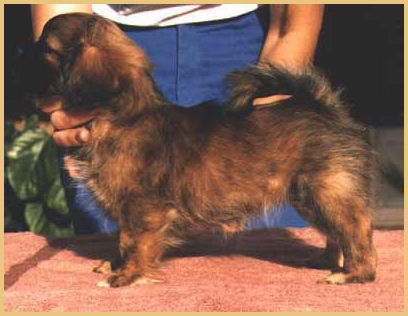
It was fortunate that we
had living here an English breeder who admitted
that she had seen such an animal in England, but
had been told it was nothing to worry about and
if she got one to ignore it. However, she agreed
that something should be done . This began a hunt
for what we in Australia call a
‘Prapso’.
The first step taken was
an inspection of every Apso we could trace. Two
more Prapsos were discovered . There were not so
many breeders then as there are today and the
majority were intelligent people prepared to help
in any way they could.
The policy decided upon
was to put Prapsos with people who only wanted a
pet dog- on condition that they would be used for
experimental matings. No registration papers were
to be given.
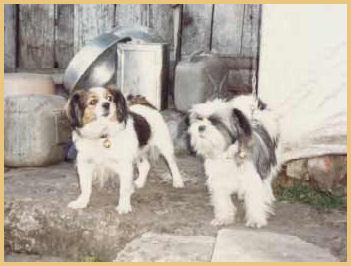
Littermates
As soon as we could, we
mated Prapso to Prapso, Apso to Prapso and our
own Apsos in various combinations which we
thought might produce Prapsos, in order to find
out how this thing was inherited.
Whilst waiting for the
results of these tests, I started writing to
everyone I could find overseas, who might know
anything about the problem. I asked for the
results of various matings, whether they be Apsos
or Prapsos, as much information about the dogs
themselves (faults, etc) and at what age certain
developments took place.
Most people were only too
happy to help. Some only after being assured that
the information would be kept confidential. This
was done.
Meantime I had been in
touch with an organisation in England called
CHART which specialises exclusively in detecting
the cause of abnormalities in animals. They are a
non-profit organisation. Each animal is given an
ordinary number which goes in the chart of where
the defect occurs or did not- as the case may be.
Thus, anyone looking at the chart would not know
the names of any of the animals concerned. When
complete, these charts are sent to a number of
leading geneticists to work on.
Unlike white Boxers or
other oddities, you cannot pick a Prapso before
6-8 weeks of age. We were , therefore, looking
for something which might help us to pick them
earlier. An interesting point arose from the
piles of information sent by the various overseas
breeders, which confirmed our own observations.
In every case, Prapsos cut their teeth by 4-5
weeks ; the Apsos were slower.
Our test matings soon
ruled out straight dominant or recessive genes.
CHART’s report was therefore eagerly
awaited. When it came, it was to say it was
quantitative genetics.
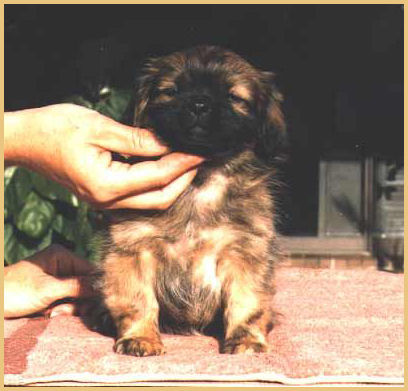
Quantitative inheritance
involves characteristics which depend on the
interaction of a very large number of genes, all
able to affect each other in varying degrees.
This type of inheritance is extremely complex.
Despite the complexity it is still within the
power of the dog breeder with little knowledge of
genetics to deal with the situation by strict
adherence to the golden rules of good dog
breeding.
One encouraging aspect is
that good specimens of the breed that have
produced Prapsos do not need to be written out of
a breeding programme, as would be the case if it
were a straight dominant/ recessive relationship,
but may be used with discretion for their good
qualities.
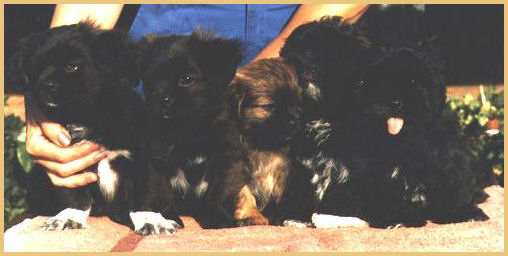
Another point which should
be born in mind is the danger of not recognising
the semi Prapso. This is an Apso with some of the
Prapso features or maybe only one. Experienced
breeders should recognise these specimens as poor
Apsos but the amateur may need to seek expert
advice. Dogs whose coats ‘cut off’
abruptly, lack feathering on the front of the
legs, sparse fall, no hair between the pads, hare
feet should be regarded with suspicion.
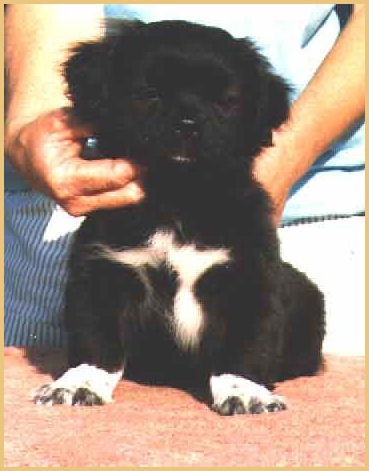
As a guide line I suggest
you find out as much as possible about the good
and the bad qualities of the dogs in your
pedigrees. Cooperate as much as possible. Take
special care when using dogs close to imports
without pedigrees. Keep complete records of
teething, development, etc. Do not repeat matings
that give disappointing results. Try and find
those that ‘nick’ and stick to the
combination. Keep and breed from those animals
nearest to the Official Standard, bearing in mind
that they must be sound in both mind and body as
well as typical.
Those who have followed
these simple rules have found that Prapsos can
occasionally turn up, often in unexpected places,
but it is now under control and can hardly be
called a ‘problem’.
On no account ever breed
from a Prapso or a semi. Sell them as pets
without papers or give them away to friends.
y y y
|